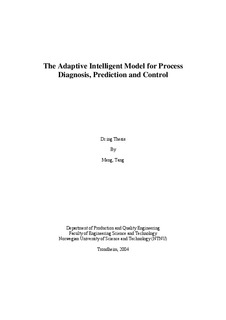| dc.contributor.advisor | Koch, Wolfgang Heinz | nb_NO |
| dc.contributor.advisor | Vatn, Jørn | nb_NO |
| dc.contributor.author | Tang, Meng | nb_NO |
| dc.date.accessioned | 2014-12-19T12:20:07Z | |
| dc.date.available | 2014-12-19T12:20:07Z | |
| dc.date.created | 2006-03-19 | nb_NO |
| dc.date.issued | 2004 | nb_NO |
| dc.identifier | 125010 | nb_NO |
| dc.identifier.isbn | 82-471-6537-6 | nb_NO |
| dc.identifier.uri | http://hdl.handle.net/11250/240609 | |
| dc.description.abstract | This research work focuses at first on the intelligent model development for process state (special for fault) detection, behavior prediction and process control for complex industrial processes. In the model architecture, Fuzzy Neural Networks (FNNs) are employed as process state classifiers for process state (fault) detection; other (different) Neural Networks (NNs) models are applied for system identification of process characteristics in different process states. The model detects process states (faults) and predicts process behavior according to process input and historical behaviors, whose combination of influences generates the final results of process state (fault) detection and quantitative prediction. The whole model is constructed based on Fuzzy TS NARX models.
Secondly, an optimal model is designed to two purposes, one is for optimal process diagnosis and another is for optimal prediction. To time varying processes, an adaptive strategy and algorithm, applying the Least Squares algorithm, has been developed for model adaptability to cover time depending process changes.
Thirdly, a specific state space equation of discrete time varying system is being derived from the model. In the state space equation, the state transition matrix A is determined by the fuzzy degree of process state classification produced by process historical behavior in time t instant, and the input transition matrix B by process real input in time t instant. The state observer vector H is determined by optimization results generated by model adaptive or optimal scheme.
Finally, to confirm the validity of the theoretical results from above, an application case has been studied for supply forecasting. The study and application results indicate that the model not only has good performance for fault detection, but also provides excellent quantitative prediction of process output. It can be applied in process state (fault) detection, diagnosis and prediction for process behavior, as well as fault predictive control. | nb_NO |
| dc.language | eng | nb_NO |
| dc.publisher | Norges teknisk-naturvitenskapelige universitet, Fakultet for ingeniørvitenskap og teknologi, Institutt for produksjons- og kvalitetsteknikk | nb_NO |
| dc.relation.ispartofseries | Doktoravhandlinger ved NTNU, 1503-8181; 2004:154 | nb_NO |
| dc.subject | Informationsteknik | en_GB |
| dc.subject | Fuzzy TS NARX model | en_GB |
| dc.subject | Adaptive intelligence model | en_GB |
| dc.subject | Diagnosis and prediction | en_GB |
| dc.subject | Process control | en_GB |
| dc.subject | TECHNOLOGY: Information technology | en_GB |
| dc.title | The Adaptive Intelligent Model for Process Diagnosis, Prediction and Control | nb_NO |
| dc.type | Doctoral thesis | nb_NO |
| dc.source.pagenumber | 172 | nb_NO |
| dc.contributor.department | Norges teknisk-naturvitenskapelige universitet, Fakultet for ingeniørvitenskap og teknologi, Institutt for produksjons- og kvalitetsteknikk | nb_NO |
| dc.description.degree | PhD i produksjons- og kvalitetsteknikk | nb_NO |
| dc.description.degree | PhD in Production and Quality Engineering | en_GB |
